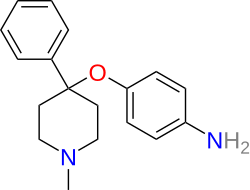B777-81
Appearance
 | |
| Clinical data | |
|---|---|
| Other names | BRN 6066682 |
| Identifiers | |
| |
| CAS Number | |
| PubChem CID | |
| ChemSpider | |
| CompTox Dashboard (EPA) | |
| Chemical and physical data | |
| Formula | C18H22N2O |
| Molar mass | 282.387 g·mol−1 |
| 3D model (JSmol) | |
| |
| |
B-777-81 is an antidepressant drug candidate.[1]
B777-81 works by reversing reserpine and tetrabenazine-induced ptosis in a similar manner to that of imipramine, but with a shorter duration of action. It also antagonizes reserpine-induced hypothermia but it is without effect on the decrease in locomotor activity or catalepsy following reserpine. In vitro, B777-81 inhibited 5-HT uptake in platelets, potentiated the effect of NA[clarification needed] on isolated vas deferens and had less anticholinergic effect than imipramine in the isolated ileum.[2][3]
References
[edit]- ^ Eistetter K, Kley HP, Menge HG, Schaefer H (1983). "B-777-81". Drugs of the Future. 8 (5): 387. doi:10.1358/dof.1983.008.05.65796.
- ^ Ankier SI (1986). "4 Recent Progress in the Development of New Antidepressant Drugs". Progress in Medicinal Chemistry. Vol. 23. Elsevier. pp. 121–185. doi:10.1016/S0079-6468(08)70342-4. ISBN 978-0-444-80802-8. PMID 3310107.
- ^ Menge HG, Brand U, Kley HP (January 1985). "Classification of New CNS-active Compounds by a Two-lever Drug Discrimination Procedure". Pharmacopsychiatry. 18 (1): 141–142. doi:10.1055/s-2007-1017346.
